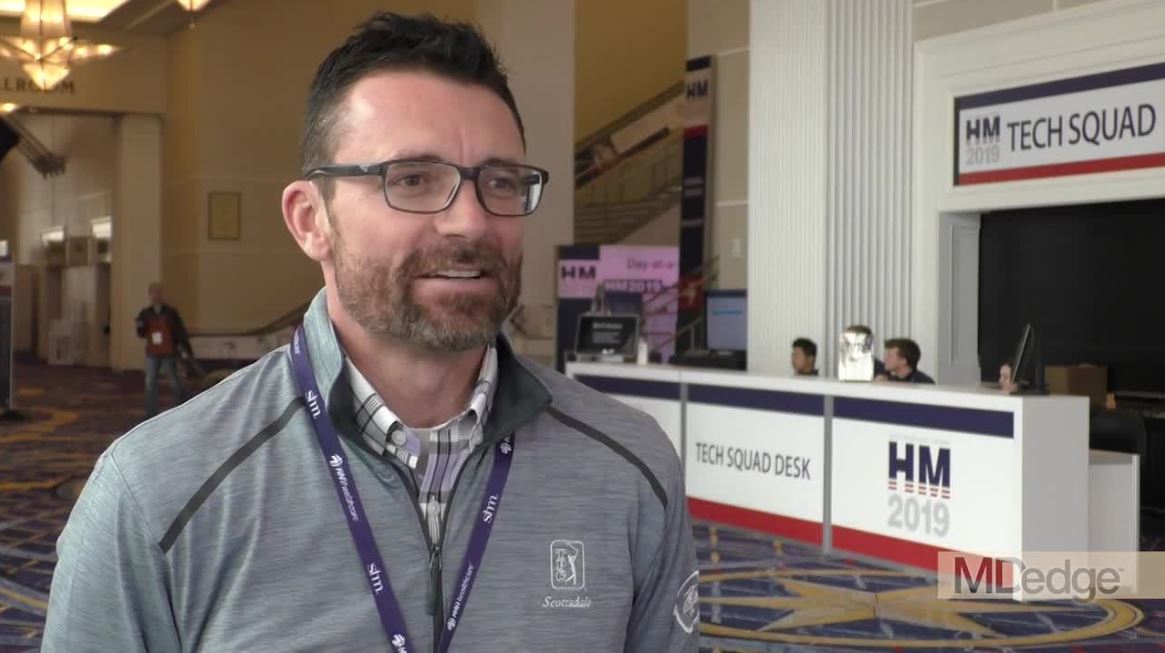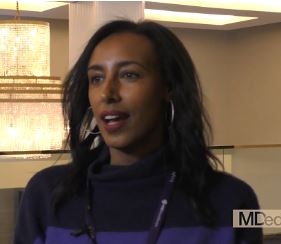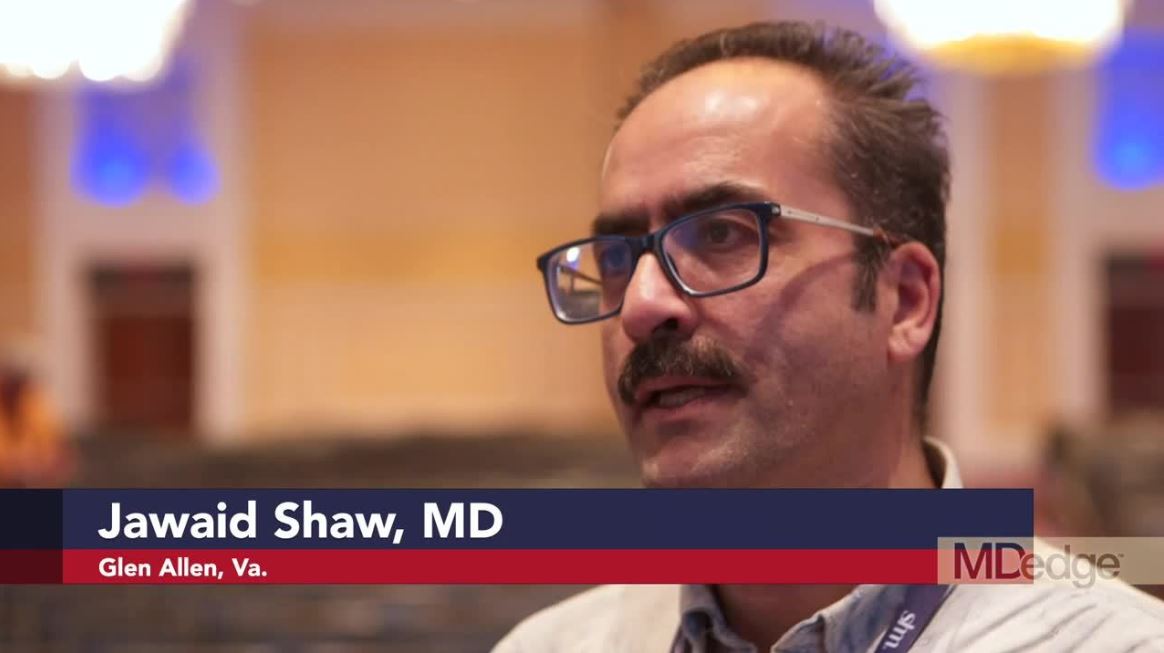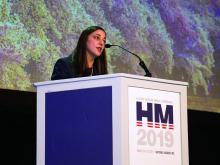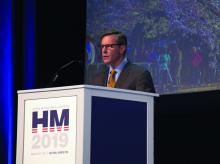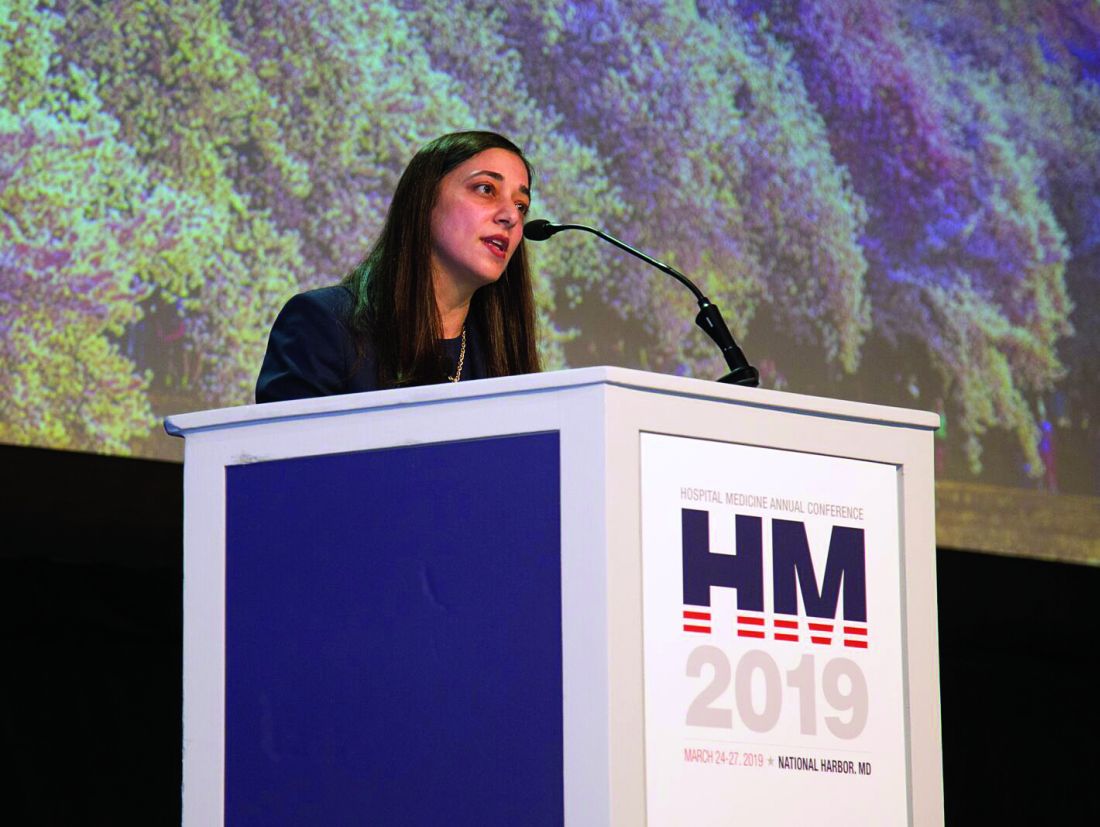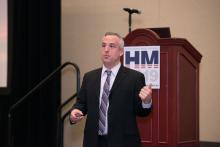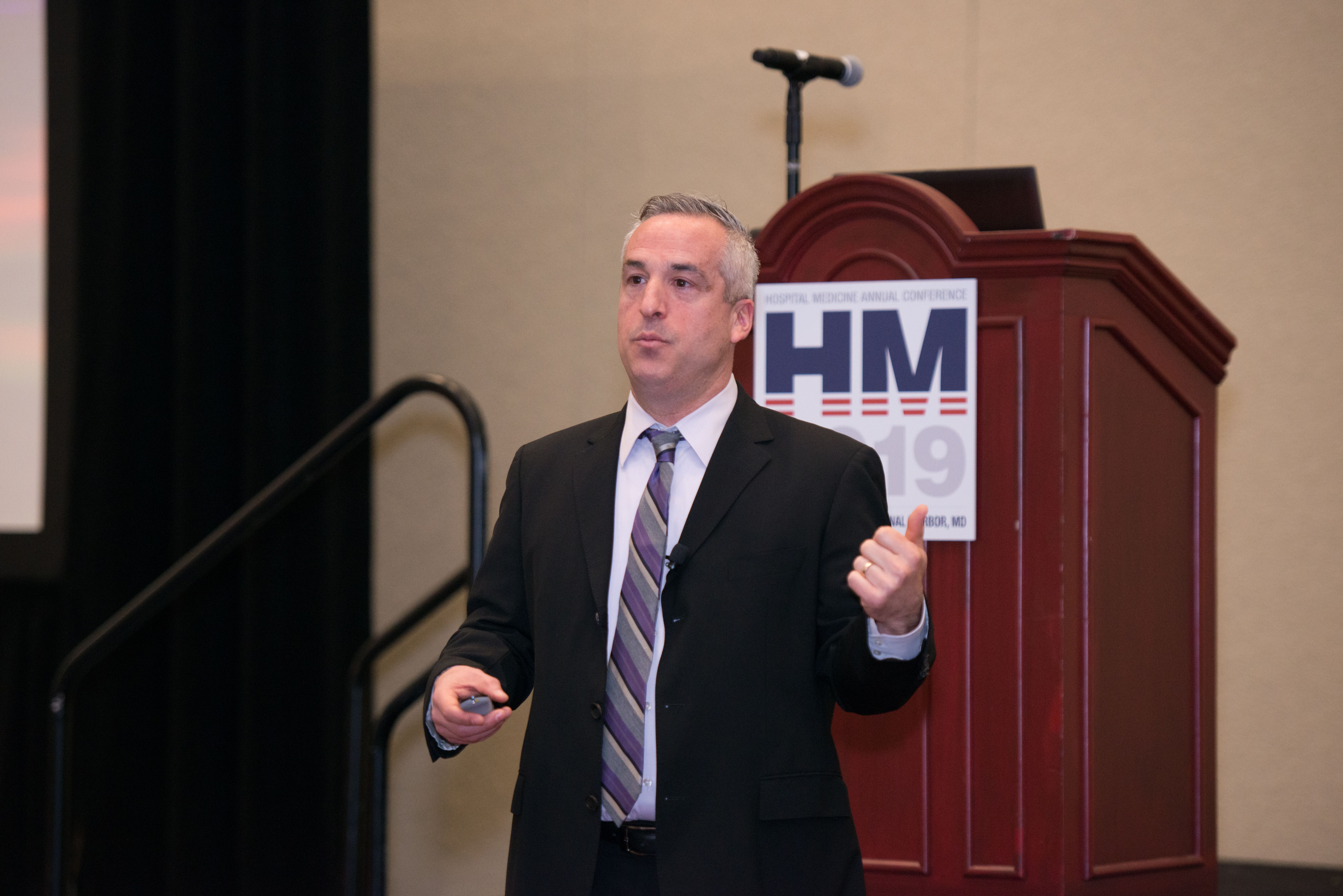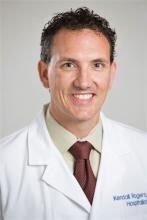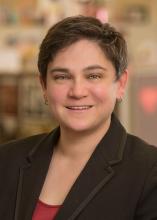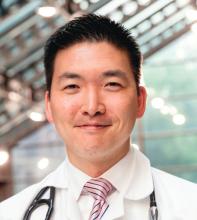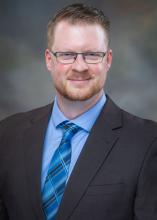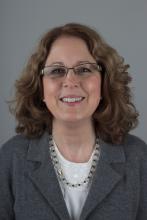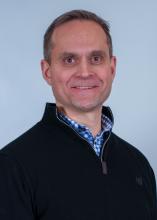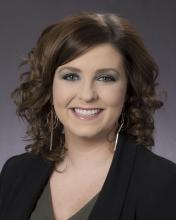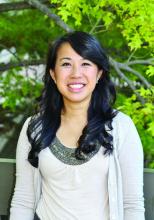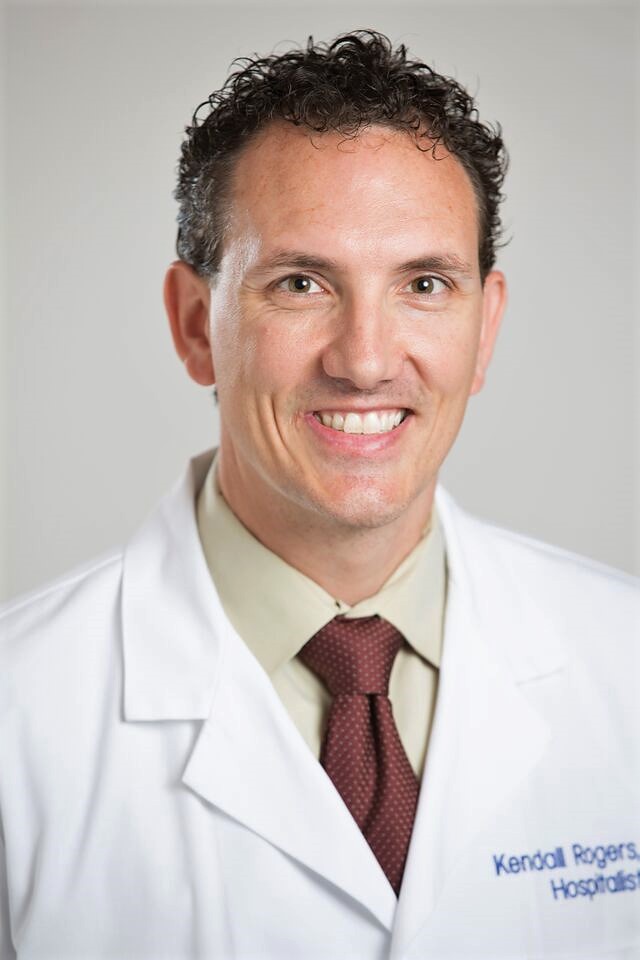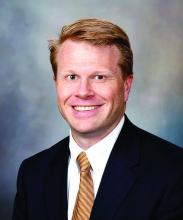User login
How has hospital medicine changed? (VIDEO)

HM19 attendees describe how hospital medicine has changed over the years.

HM19 attendees describe how hospital medicine has changed over the years.

HM19 attendees describe how hospital medicine has changed over the years.
SHM’s Research Shark Tank a resounding success
A few lucky hospitalists had the chance to compete for dedicated consultation time from experienced hospital medicine mentors during the SHM Annual Conference’s first Research Shark Tank.
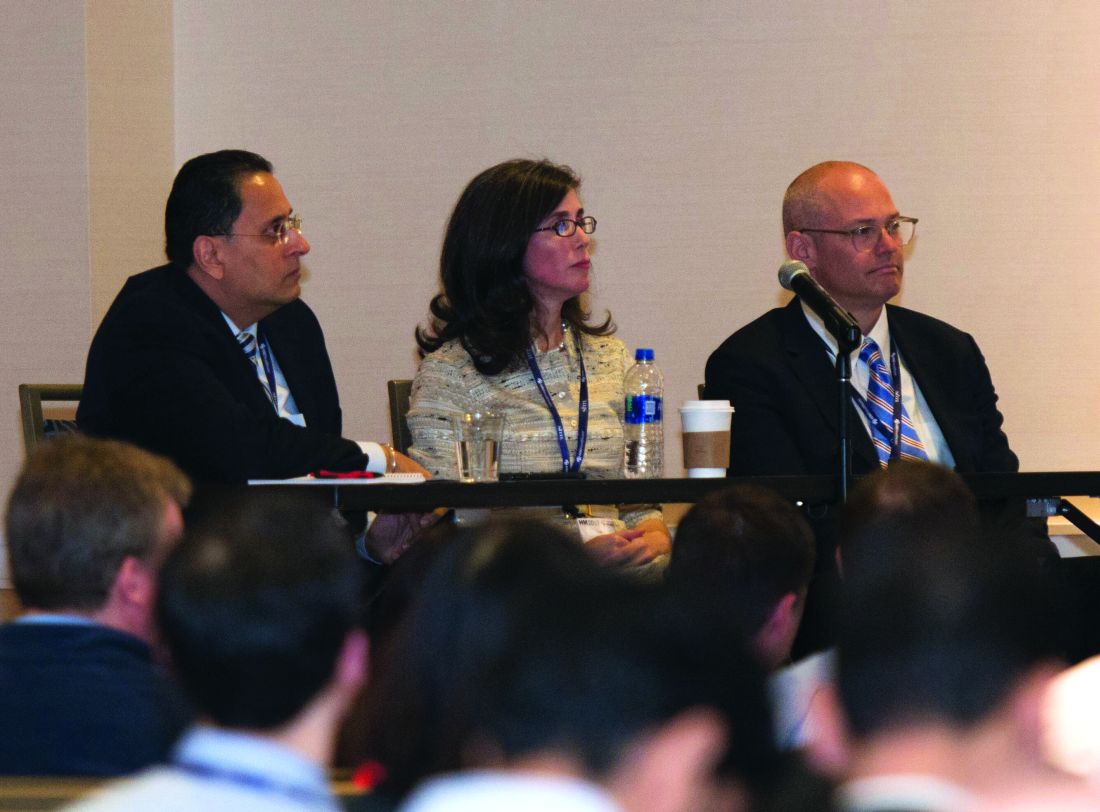
During the Monday afternoon session, four hospitalist projects were each presented in a 5-minute “pitch” to three senior quality and research leaders in hospital medicine who served as the “sharks.” These pitches were followed by 7 minutes of moderated questions and feedback from the sharks and the audience. Sharks then “bid” on the projects, offering up to 2 hours of one-on-one consultation during the conference or as needed.
The four projects included a study of the use of off-site scribes listening in to patient/hospitalist interactions to eliminate the need for the doctor to be glued to the computer screen, which was presented by Thea Dalfino, MD, chief of hospital medicine at Albany (N.Y.) Memorial Hospital; a rethinking of medical education to emphasize the role of hospitalists as mentors to individual student “apprentices,” presented by Amulya Nagarur, MD, of the department of medicine at Massachusetts General Hospital, Boston, and Christiana Renner, MD, of University of Texas Southwestern Medical Center, Dallas; and a redesign of patient hospital gowns to optimize, comfort, morale, and functionality, presented by Cheryl Dellasega, PhD, professor of medicine and humanities at Penn State University, Hershey.
The winning project was presented by Meera Udayakumar, MD, medical director at the University of North Carolina REX Healthcare in Raleigh. She discussed “The Equalizer,” a computerized tool to optimize patient distribution among hospitalists in order to balance workflow in a practice.
In discussing the thinking behind this unique session, Luci Leykum, MD, SFHM, chief of the division of general and hospital medicine at the University of Texas, San Antonio, who served as one of the sharks, stated that: “We’ve always tried to do things to promote the pipeline of research in hospital medicine and to raise the visibility of research activities at the annual conference. In the past, we have done one-on-one ‘speed dating’ with mentors, but the research committee thought this format would be more interactive and that audience members could benefit from hearing the discussion.”
The other participating sharks were Andrew Auerbach, MD, MPH, MHM, professor of medicine at the University of California, San Francisco, and former editor of the Journal of Hospital Medicine, and Hardeep Singh, MD, MPH, chief of the health policy, quality, and informatics program at the Center for Innovations in Quality, Effectiveness, and Safety at the Michael E. DeBakey Veterans Affairs Medical Center in Houston.
The selection process for those looking to pitch was rigorous. Projects submitted to the research committee had to focus on research, quality improvement, or medical education and be very specific to the practice of hospital medicine. In addition, the ideas needed to be relatively well developed, ideally with some pilot data. Applicants also needed to address a significant problem in hospital medicine, showcase an innovative approach, and make the case for how their solution would have short- and long-term effects.
Dr. Leykum said she was looking to see whether the pitched projects have clearly articulated questions that are important and interesting and whether the proposed methods would sufficiently answer those questions. She also considered what the implications were if the work was done.
Audience members had a chance to ask questions and, if they were interested, to potentially partner with presenters or adopt similar ideas at their own institutions. Attendees were exposed to innovative ways of solving problems that are common and ideas that have a big impact on the way problems are approached in hospital medicine.
“I think it was a fun, fast, interactive session, and it was interesting to see,” said Dr. Leykum. “Those of us who were the sharks know each other and each other’s work, so that was a fun dynamic.”
A few lucky hospitalists had the chance to compete for dedicated consultation time from experienced hospital medicine mentors during the SHM Annual Conference’s first Research Shark Tank.

During the Monday afternoon session, four hospitalist projects were each presented in a 5-minute “pitch” to three senior quality and research leaders in hospital medicine who served as the “sharks.” These pitches were followed by 7 minutes of moderated questions and feedback from the sharks and the audience. Sharks then “bid” on the projects, offering up to 2 hours of one-on-one consultation during the conference or as needed.
The four projects included a study of the use of off-site scribes listening in to patient/hospitalist interactions to eliminate the need for the doctor to be glued to the computer screen, which was presented by Thea Dalfino, MD, chief of hospital medicine at Albany (N.Y.) Memorial Hospital; a rethinking of medical education to emphasize the role of hospitalists as mentors to individual student “apprentices,” presented by Amulya Nagarur, MD, of the department of medicine at Massachusetts General Hospital, Boston, and Christiana Renner, MD, of University of Texas Southwestern Medical Center, Dallas; and a redesign of patient hospital gowns to optimize, comfort, morale, and functionality, presented by Cheryl Dellasega, PhD, professor of medicine and humanities at Penn State University, Hershey.
The winning project was presented by Meera Udayakumar, MD, medical director at the University of North Carolina REX Healthcare in Raleigh. She discussed “The Equalizer,” a computerized tool to optimize patient distribution among hospitalists in order to balance workflow in a practice.
In discussing the thinking behind this unique session, Luci Leykum, MD, SFHM, chief of the division of general and hospital medicine at the University of Texas, San Antonio, who served as one of the sharks, stated that: “We’ve always tried to do things to promote the pipeline of research in hospital medicine and to raise the visibility of research activities at the annual conference. In the past, we have done one-on-one ‘speed dating’ with mentors, but the research committee thought this format would be more interactive and that audience members could benefit from hearing the discussion.”
The other participating sharks were Andrew Auerbach, MD, MPH, MHM, professor of medicine at the University of California, San Francisco, and former editor of the Journal of Hospital Medicine, and Hardeep Singh, MD, MPH, chief of the health policy, quality, and informatics program at the Center for Innovations in Quality, Effectiveness, and Safety at the Michael E. DeBakey Veterans Affairs Medical Center in Houston.
The selection process for those looking to pitch was rigorous. Projects submitted to the research committee had to focus on research, quality improvement, or medical education and be very specific to the practice of hospital medicine. In addition, the ideas needed to be relatively well developed, ideally with some pilot data. Applicants also needed to address a significant problem in hospital medicine, showcase an innovative approach, and make the case for how their solution would have short- and long-term effects.
Dr. Leykum said she was looking to see whether the pitched projects have clearly articulated questions that are important and interesting and whether the proposed methods would sufficiently answer those questions. She also considered what the implications were if the work was done.
Audience members had a chance to ask questions and, if they were interested, to potentially partner with presenters or adopt similar ideas at their own institutions. Attendees were exposed to innovative ways of solving problems that are common and ideas that have a big impact on the way problems are approached in hospital medicine.
“I think it was a fun, fast, interactive session, and it was interesting to see,” said Dr. Leykum. “Those of us who were the sharks know each other and each other’s work, so that was a fun dynamic.”
A few lucky hospitalists had the chance to compete for dedicated consultation time from experienced hospital medicine mentors during the SHM Annual Conference’s first Research Shark Tank.

During the Monday afternoon session, four hospitalist projects were each presented in a 5-minute “pitch” to three senior quality and research leaders in hospital medicine who served as the “sharks.” These pitches were followed by 7 minutes of moderated questions and feedback from the sharks and the audience. Sharks then “bid” on the projects, offering up to 2 hours of one-on-one consultation during the conference or as needed.
The four projects included a study of the use of off-site scribes listening in to patient/hospitalist interactions to eliminate the need for the doctor to be glued to the computer screen, which was presented by Thea Dalfino, MD, chief of hospital medicine at Albany (N.Y.) Memorial Hospital; a rethinking of medical education to emphasize the role of hospitalists as mentors to individual student “apprentices,” presented by Amulya Nagarur, MD, of the department of medicine at Massachusetts General Hospital, Boston, and Christiana Renner, MD, of University of Texas Southwestern Medical Center, Dallas; and a redesign of patient hospital gowns to optimize, comfort, morale, and functionality, presented by Cheryl Dellasega, PhD, professor of medicine and humanities at Penn State University, Hershey.
The winning project was presented by Meera Udayakumar, MD, medical director at the University of North Carolina REX Healthcare in Raleigh. She discussed “The Equalizer,” a computerized tool to optimize patient distribution among hospitalists in order to balance workflow in a practice.
In discussing the thinking behind this unique session, Luci Leykum, MD, SFHM, chief of the division of general and hospital medicine at the University of Texas, San Antonio, who served as one of the sharks, stated that: “We’ve always tried to do things to promote the pipeline of research in hospital medicine and to raise the visibility of research activities at the annual conference. In the past, we have done one-on-one ‘speed dating’ with mentors, but the research committee thought this format would be more interactive and that audience members could benefit from hearing the discussion.”
The other participating sharks were Andrew Auerbach, MD, MPH, MHM, professor of medicine at the University of California, San Francisco, and former editor of the Journal of Hospital Medicine, and Hardeep Singh, MD, MPH, chief of the health policy, quality, and informatics program at the Center for Innovations in Quality, Effectiveness, and Safety at the Michael E. DeBakey Veterans Affairs Medical Center in Houston.
The selection process for those looking to pitch was rigorous. Projects submitted to the research committee had to focus on research, quality improvement, or medical education and be very specific to the practice of hospital medicine. In addition, the ideas needed to be relatively well developed, ideally with some pilot data. Applicants also needed to address a significant problem in hospital medicine, showcase an innovative approach, and make the case for how their solution would have short- and long-term effects.
Dr. Leykum said she was looking to see whether the pitched projects have clearly articulated questions that are important and interesting and whether the proposed methods would sufficiently answer those questions. She also considered what the implications were if the work was done.
Audience members had a chance to ask questions and, if they were interested, to potentially partner with presenters or adopt similar ideas at their own institutions. Attendees were exposed to innovative ways of solving problems that are common and ideas that have a big impact on the way problems are approached in hospital medicine.
“I think it was a fun, fast, interactive session, and it was interesting to see,” said Dr. Leykum. “Those of us who were the sharks know each other and each other’s work, so that was a fun dynamic.”
Announcing the 2019 chapter awards and grant recipients
Chapter Excellence Awards
The Society of Hospital Medicine is proud to recognize its chapters for their hard work and dedication through Chapter Excellence Awards. Each year, chapters strive to demonstrate growth, sustainability, and innovation within their activities, which are then recognized at SHM’s annual conference.
Please join SHM in congratulating the following chapters on their year of success in 2018!
Platinum Chapters: Iowa; Knoxville; Maryland; Michigan; Minnesota; New Mexico; North Carolina Triangle; Pacific Northwest; Southwest Florida; Wiregrass.
Gold Chapters: Houston; NYC/Westchester; Piedmont Triad; San Francisco Bay Area
Silver Chapters: Boston/Eastern Massachusetts; Charlotte Metro Area; Gulf States; Hampton Roads; Kentucky; Maine; Nebraska; North Jersey; Rocky Mountain; South Central Pennsylvania; South Texas; St. Louis.
Outstanding Chapter of the Year
Michigan. The Outstanding Chapter of the Year Award goes to one chapter that exemplifies high performance, going above and beyond the basic chapter requirements. The recipient of the Outstanding Chapter of the Year Award for 2018 is the Michigan chapter of SHM.
The Michigan chapter continues to embrace the mission of our society and nurtures a vibrant, multidisciplinary membership. It is currently the largest chapter in the program, representing more than 750 SHM members.
Using a technology-enabled platform, the Michigan chapter has expanded its meetings to four different sites, leveraging expertise from across the state. The chapter recently held its largest meeting focused on provider burnout, with more than 100 attendees across four different sites. It featured a main speaker as well as a multidisciplinary panel of leaders from eight different health systems.
The chapter has successfully incorporated advocacy into its annual planning and actively responds to new legislation affecting hospital medicine. It continues to be an active and valued member of the Michigan medical community and the SHM chapter community at large.
In addition to the service to members, the chapter strives to serve the SHM chapter community at large by collaborating and sharing best practices.
The chapter’s level of originality is not only a benefit to the chapter, but also to SHM’s Chapter program as a whole. Congratulations to the Michigan chapter on being named the Outstanding Chapter of 2018.
Rising Star Chapter
Knoxville. The Rising Star Chapter Award goes to one chapter that has been active for 2 years or less and in the past 12 months has made improvements to its leadership, stability and growth, and membership.
The recipient of the Rising Star Chapter Award for 2018 is the Knoxville (Tenn.) Chapter of SHM, which has made significant strides since its launch in the spring of 2017. The chapter assembled a group of local hospitalists from Knoxville and the surrounding region to encourage participation and drive quality initiatives in area hospitals.
The Knoxville chapter developed a leadership framework, including officers and board members, and just completed its first formal chapter leadership election. In 2018, the chapter held four meetings, including an event steered toward residents and students. Membership in the chapter has grown by more than 20% since inception. The chapter has engaged in statewide quality initiatives with the Tennessee Hospital Association and has engaged with other chapters across the state.
The Knoxville’s Chapter is an active, enthusiastic organization that is rapidly growing and thriving. Congratulations to the Knoxville chapter on being named the Rising Star Chapter for 2018.
Student Hospitalist Scholar Grant recipients
SHM is proud to acknowledge the latest winners of its Student Hospitalist Scholar Grant. These medical students were awarded grants to complete scholarly work with an active SHM mentor in a project related to patient safety, quality improvement, or other areas relevant to the field of hospital medicine.
Sandeep Bala
University of Chicago Pritzker School of Medicine
Poster 382 – The impact of plain language open medical notes on patient activation
Location: Denver (Colo.) Health Hospital
Monisha Bhatia
Vanderbilt University School of Medicine
Poster 23 – Using electronic medical record phenotypic data to predict discharge destination
Location: Vanderbilt University Medical Center, Nashville, Tenn.
Maximilian Hemmrich
University of Chicago Pritzker School of Medicine
Oral presentation, 11:45 a.m. – Noon, Tuesday, March 26
Project: Derivation and validation of a COPD readmission risk prediction tool
Location: University of Chicago
Ilana Scandariato Lavina
Weill Cornell Medical College
Poster 424 – Understanding the experience of the long-term hospitalized patient with provider fragmentation: A qualitative study
Yun Li
Geisel School of Medicine at Dartmouth
Poster 320 – Developing and implementing clinical pathway(s) for hospitalized injection drug users due to injection-related infection sequelae
Location: Dartmouth-Hitchcock Medical Center, Lebanon, N.H.
Resident Travel Grant recipients
We would like to congratulate the latest winners of SHM’s Resident Travel Grant. To qualify for this award, residents submitted an abstract for consideration in the RIV session at HM19 as first authors. Each of them produced outstanding work worthy of recognition:
Daniel Choi, MD – New York Presbyterian Hospital–Weill Cornell
Poster 277 – Improving rates of appropriate ICD deactivation discussions in admitted patients made DNR and/or comfort care
Armond Esmaili, MD – University of California, San Francisco, and the San Francisco VA Medical Center
Poster 649 – Early isolated hypotension, a sepsis “Canary in the Coal Mine”: Timing of antibiotics according to hypotension identifies different sepsis subtypes at differing risks of treatment delay
Poster 8 – Who’s waiting? Predictors of antibiotic delays in hypotensive patients with sepsis
Geoffroy Fauchet, MD – University of Colorado at Denver, Aurora – Rocky Mountain Regional VA Medical Center
Poster 288 – Tackling opioid prescriptions through resident engagement
Nick Zessis, MD – Washington University School of Medicine, St. Louis Children’s Hospital
Poster 101 – Smartphone-based teaching app increases frequency of residents teaching medical students
David Sterken, MD – University of California, San Francisco
Poster 230 – Safety of antimotility agent use during treatment for Clostridioides difficile infection in malignant hepatology patients
James Anstey, MD – University of California, San Francisco
Poster 57 – The POCUS supervision safety gap: Attending physician knowledge in point-of-care ultrasound lags behind that of internal medicine residents
Poster 147 – Association of post paracentesis albumin dosage and acute kidney injury in hospitalized patients
Nicholas Iverson, MD – University of California, San Francisco
Poster 408 – Implications of using an alternative measure to assess opiate days supplied at discharge
Marwah Shahid, MD – Baylor College of Medicine, Houston
Poster 22 – Topic modeling to evaluate hospital Google reviews
Abhishek Chaturvedi, MD – Allegheny Health Network, Pittsburgh
Poster 152 – Association of socioeconomic and racial disparities with health care utilization and outcomes in opioid overdose–related hospitalizations in the United States: Insights from National Inpatient Sample from 2012 through 2014
Pratyusha Tirumanisetty, MD – Unity Hospital, Rochester (N.Y.) Regional Health
Poster 9 – Does hospital-onset Clostridium difficile infection increase the risk of hospital discharge to skilled nursing facilities? A retrospective case-control study from a community hospital.
Chapter Excellence Awards
The Society of Hospital Medicine is proud to recognize its chapters for their hard work and dedication through Chapter Excellence Awards. Each year, chapters strive to demonstrate growth, sustainability, and innovation within their activities, which are then recognized at SHM’s annual conference.
Please join SHM in congratulating the following chapters on their year of success in 2018!
Platinum Chapters: Iowa; Knoxville; Maryland; Michigan; Minnesota; New Mexico; North Carolina Triangle; Pacific Northwest; Southwest Florida; Wiregrass.
Gold Chapters: Houston; NYC/Westchester; Piedmont Triad; San Francisco Bay Area
Silver Chapters: Boston/Eastern Massachusetts; Charlotte Metro Area; Gulf States; Hampton Roads; Kentucky; Maine; Nebraska; North Jersey; Rocky Mountain; South Central Pennsylvania; South Texas; St. Louis.
Outstanding Chapter of the Year
Michigan. The Outstanding Chapter of the Year Award goes to one chapter that exemplifies high performance, going above and beyond the basic chapter requirements. The recipient of the Outstanding Chapter of the Year Award for 2018 is the Michigan chapter of SHM.
The Michigan chapter continues to embrace the mission of our society and nurtures a vibrant, multidisciplinary membership. It is currently the largest chapter in the program, representing more than 750 SHM members.
Using a technology-enabled platform, the Michigan chapter has expanded its meetings to four different sites, leveraging expertise from across the state. The chapter recently held its largest meeting focused on provider burnout, with more than 100 attendees across four different sites. It featured a main speaker as well as a multidisciplinary panel of leaders from eight different health systems.
The chapter has successfully incorporated advocacy into its annual planning and actively responds to new legislation affecting hospital medicine. It continues to be an active and valued member of the Michigan medical community and the SHM chapter community at large.
In addition to the service to members, the chapter strives to serve the SHM chapter community at large by collaborating and sharing best practices.
The chapter’s level of originality is not only a benefit to the chapter, but also to SHM’s Chapter program as a whole. Congratulations to the Michigan chapter on being named the Outstanding Chapter of 2018.
Rising Star Chapter
Knoxville. The Rising Star Chapter Award goes to one chapter that has been active for 2 years or less and in the past 12 months has made improvements to its leadership, stability and growth, and membership.
The recipient of the Rising Star Chapter Award for 2018 is the Knoxville (Tenn.) Chapter of SHM, which has made significant strides since its launch in the spring of 2017. The chapter assembled a group of local hospitalists from Knoxville and the surrounding region to encourage participation and drive quality initiatives in area hospitals.
The Knoxville chapter developed a leadership framework, including officers and board members, and just completed its first formal chapter leadership election. In 2018, the chapter held four meetings, including an event steered toward residents and students. Membership in the chapter has grown by more than 20% since inception. The chapter has engaged in statewide quality initiatives with the Tennessee Hospital Association and has engaged with other chapters across the state.
The Knoxville’s Chapter is an active, enthusiastic organization that is rapidly growing and thriving. Congratulations to the Knoxville chapter on being named the Rising Star Chapter for 2018.
Student Hospitalist Scholar Grant recipients
SHM is proud to acknowledge the latest winners of its Student Hospitalist Scholar Grant. These medical students were awarded grants to complete scholarly work with an active SHM mentor in a project related to patient safety, quality improvement, or other areas relevant to the field of hospital medicine.
Sandeep Bala
University of Chicago Pritzker School of Medicine
Poster 382 – The impact of plain language open medical notes on patient activation
Location: Denver (Colo.) Health Hospital
Monisha Bhatia
Vanderbilt University School of Medicine
Poster 23 – Using electronic medical record phenotypic data to predict discharge destination
Location: Vanderbilt University Medical Center, Nashville, Tenn.
Maximilian Hemmrich
University of Chicago Pritzker School of Medicine
Oral presentation, 11:45 a.m. – Noon, Tuesday, March 26
Project: Derivation and validation of a COPD readmission risk prediction tool
Location: University of Chicago
Ilana Scandariato Lavina
Weill Cornell Medical College
Poster 424 – Understanding the experience of the long-term hospitalized patient with provider fragmentation: A qualitative study
Yun Li
Geisel School of Medicine at Dartmouth
Poster 320 – Developing and implementing clinical pathway(s) for hospitalized injection drug users due to injection-related infection sequelae
Location: Dartmouth-Hitchcock Medical Center, Lebanon, N.H.
Resident Travel Grant recipients
We would like to congratulate the latest winners of SHM’s Resident Travel Grant. To qualify for this award, residents submitted an abstract for consideration in the RIV session at HM19 as first authors. Each of them produced outstanding work worthy of recognition:
Daniel Choi, MD – New York Presbyterian Hospital–Weill Cornell
Poster 277 – Improving rates of appropriate ICD deactivation discussions in admitted patients made DNR and/or comfort care
Armond Esmaili, MD – University of California, San Francisco, and the San Francisco VA Medical Center
Poster 649 – Early isolated hypotension, a sepsis “Canary in the Coal Mine”: Timing of antibiotics according to hypotension identifies different sepsis subtypes at differing risks of treatment delay
Poster 8 – Who’s waiting? Predictors of antibiotic delays in hypotensive patients with sepsis
Geoffroy Fauchet, MD – University of Colorado at Denver, Aurora – Rocky Mountain Regional VA Medical Center
Poster 288 – Tackling opioid prescriptions through resident engagement
Nick Zessis, MD – Washington University School of Medicine, St. Louis Children’s Hospital
Poster 101 – Smartphone-based teaching app increases frequency of residents teaching medical students
David Sterken, MD – University of California, San Francisco
Poster 230 – Safety of antimotility agent use during treatment for Clostridioides difficile infection in malignant hepatology patients
James Anstey, MD – University of California, San Francisco
Poster 57 – The POCUS supervision safety gap: Attending physician knowledge in point-of-care ultrasound lags behind that of internal medicine residents
Poster 147 – Association of post paracentesis albumin dosage and acute kidney injury in hospitalized patients
Nicholas Iverson, MD – University of California, San Francisco
Poster 408 – Implications of using an alternative measure to assess opiate days supplied at discharge
Marwah Shahid, MD – Baylor College of Medicine, Houston
Poster 22 – Topic modeling to evaluate hospital Google reviews
Abhishek Chaturvedi, MD – Allegheny Health Network, Pittsburgh
Poster 152 – Association of socioeconomic and racial disparities with health care utilization and outcomes in opioid overdose–related hospitalizations in the United States: Insights from National Inpatient Sample from 2012 through 2014
Pratyusha Tirumanisetty, MD – Unity Hospital, Rochester (N.Y.) Regional Health
Poster 9 – Does hospital-onset Clostridium difficile infection increase the risk of hospital discharge to skilled nursing facilities? A retrospective case-control study from a community hospital.
Chapter Excellence Awards
The Society of Hospital Medicine is proud to recognize its chapters for their hard work and dedication through Chapter Excellence Awards. Each year, chapters strive to demonstrate growth, sustainability, and innovation within their activities, which are then recognized at SHM’s annual conference.
Please join SHM in congratulating the following chapters on their year of success in 2018!
Platinum Chapters: Iowa; Knoxville; Maryland; Michigan; Minnesota; New Mexico; North Carolina Triangle; Pacific Northwest; Southwest Florida; Wiregrass.
Gold Chapters: Houston; NYC/Westchester; Piedmont Triad; San Francisco Bay Area
Silver Chapters: Boston/Eastern Massachusetts; Charlotte Metro Area; Gulf States; Hampton Roads; Kentucky; Maine; Nebraska; North Jersey; Rocky Mountain; South Central Pennsylvania; South Texas; St. Louis.
Outstanding Chapter of the Year
Michigan. The Outstanding Chapter of the Year Award goes to one chapter that exemplifies high performance, going above and beyond the basic chapter requirements. The recipient of the Outstanding Chapter of the Year Award for 2018 is the Michigan chapter of SHM.
The Michigan chapter continues to embrace the mission of our society and nurtures a vibrant, multidisciplinary membership. It is currently the largest chapter in the program, representing more than 750 SHM members.
Using a technology-enabled platform, the Michigan chapter has expanded its meetings to four different sites, leveraging expertise from across the state. The chapter recently held its largest meeting focused on provider burnout, with more than 100 attendees across four different sites. It featured a main speaker as well as a multidisciplinary panel of leaders from eight different health systems.
The chapter has successfully incorporated advocacy into its annual planning and actively responds to new legislation affecting hospital medicine. It continues to be an active and valued member of the Michigan medical community and the SHM chapter community at large.
In addition to the service to members, the chapter strives to serve the SHM chapter community at large by collaborating and sharing best practices.
The chapter’s level of originality is not only a benefit to the chapter, but also to SHM’s Chapter program as a whole. Congratulations to the Michigan chapter on being named the Outstanding Chapter of 2018.
Rising Star Chapter
Knoxville. The Rising Star Chapter Award goes to one chapter that has been active for 2 years or less and in the past 12 months has made improvements to its leadership, stability and growth, and membership.
The recipient of the Rising Star Chapter Award for 2018 is the Knoxville (Tenn.) Chapter of SHM, which has made significant strides since its launch in the spring of 2017. The chapter assembled a group of local hospitalists from Knoxville and the surrounding region to encourage participation and drive quality initiatives in area hospitals.
The Knoxville chapter developed a leadership framework, including officers and board members, and just completed its first formal chapter leadership election. In 2018, the chapter held four meetings, including an event steered toward residents and students. Membership in the chapter has grown by more than 20% since inception. The chapter has engaged in statewide quality initiatives with the Tennessee Hospital Association and has engaged with other chapters across the state.
The Knoxville’s Chapter is an active, enthusiastic organization that is rapidly growing and thriving. Congratulations to the Knoxville chapter on being named the Rising Star Chapter for 2018.
Student Hospitalist Scholar Grant recipients
SHM is proud to acknowledge the latest winners of its Student Hospitalist Scholar Grant. These medical students were awarded grants to complete scholarly work with an active SHM mentor in a project related to patient safety, quality improvement, or other areas relevant to the field of hospital medicine.
Sandeep Bala
University of Chicago Pritzker School of Medicine
Poster 382 – The impact of plain language open medical notes on patient activation
Location: Denver (Colo.) Health Hospital
Monisha Bhatia
Vanderbilt University School of Medicine
Poster 23 – Using electronic medical record phenotypic data to predict discharge destination
Location: Vanderbilt University Medical Center, Nashville, Tenn.
Maximilian Hemmrich
University of Chicago Pritzker School of Medicine
Oral presentation, 11:45 a.m. – Noon, Tuesday, March 26
Project: Derivation and validation of a COPD readmission risk prediction tool
Location: University of Chicago
Ilana Scandariato Lavina
Weill Cornell Medical College
Poster 424 – Understanding the experience of the long-term hospitalized patient with provider fragmentation: A qualitative study
Yun Li
Geisel School of Medicine at Dartmouth
Poster 320 – Developing and implementing clinical pathway(s) for hospitalized injection drug users due to injection-related infection sequelae
Location: Dartmouth-Hitchcock Medical Center, Lebanon, N.H.
Resident Travel Grant recipients
We would like to congratulate the latest winners of SHM’s Resident Travel Grant. To qualify for this award, residents submitted an abstract for consideration in the RIV session at HM19 as first authors. Each of them produced outstanding work worthy of recognition:
Daniel Choi, MD – New York Presbyterian Hospital–Weill Cornell
Poster 277 – Improving rates of appropriate ICD deactivation discussions in admitted patients made DNR and/or comfort care
Armond Esmaili, MD – University of California, San Francisco, and the San Francisco VA Medical Center
Poster 649 – Early isolated hypotension, a sepsis “Canary in the Coal Mine”: Timing of antibiotics according to hypotension identifies different sepsis subtypes at differing risks of treatment delay
Poster 8 – Who’s waiting? Predictors of antibiotic delays in hypotensive patients with sepsis
Geoffroy Fauchet, MD – University of Colorado at Denver, Aurora – Rocky Mountain Regional VA Medical Center
Poster 288 – Tackling opioid prescriptions through resident engagement
Nick Zessis, MD – Washington University School of Medicine, St. Louis Children’s Hospital
Poster 101 – Smartphone-based teaching app increases frequency of residents teaching medical students
David Sterken, MD – University of California, San Francisco
Poster 230 – Safety of antimotility agent use during treatment for Clostridioides difficile infection in malignant hepatology patients
James Anstey, MD – University of California, San Francisco
Poster 57 – The POCUS supervision safety gap: Attending physician knowledge in point-of-care ultrasound lags behind that of internal medicine residents
Poster 147 – Association of post paracentesis albumin dosage and acute kidney injury in hospitalized patients
Nicholas Iverson, MD – University of California, San Francisco
Poster 408 – Implications of using an alternative measure to assess opiate days supplied at discharge
Marwah Shahid, MD – Baylor College of Medicine, Houston
Poster 22 – Topic modeling to evaluate hospital Google reviews
Abhishek Chaturvedi, MD – Allegheny Health Network, Pittsburgh
Poster 152 – Association of socioeconomic and racial disparities with health care utilization and outcomes in opioid overdose–related hospitalizations in the United States: Insights from National Inpatient Sample from 2012 through 2014
Pratyusha Tirumanisetty, MD – Unity Hospital, Rochester (N.Y.) Regional Health
Poster 9 – Does hospital-onset Clostridium difficile infection increase the risk of hospital discharge to skilled nursing facilities? A retrospective case-control study from a community hospital.
SHM Chapter leaders highlight their local programs (VIDEO)
Leaders of SHM chapters give their take-away points from the Chapter Leader Training Program and highlights from their own local programs.

Leaders of SHM chapters give their take-away points from the Chapter Leader Training Program and highlights from their own local programs.

Leaders of SHM chapters give their take-away points from the Chapter Leader Training Program and highlights from their own local programs.

Highlights from the "Updates in Sepsis" session (VIDEO)

HM19 attendees discuss key take-home points from Monday’s Update in Sepsis session.

HM19 attendees discuss key take-home points from Monday’s Update in Sepsis session.

HM19 attendees discuss key take-home points from Monday’s Update in Sepsis session.
Adapting to change key to hospitalists’ future, SHM president says
Society of Hospital Medicine President Nasim Afsar, MD, SFHM, told a packed ballroom of hospitalists at HM19 on Monday that it’s not change to the health care industry that is most central to their future, but it’s how they assume a role within it and how they spark it themselves.
With a tone that was, at times, almost ebullient about change, Dr. Afsar characterized the flux of health care as a series of opportunities to improve patient care.
“Run toward change,” said Dr. Afsar, chief ambulatory officer and chief medical officer for accountable care organizations at University of California, Irvine. “And be a force of positive change.”
The push toward affordability and value has made for some “unlikely partners,” she noted, including the health care venture launched by Amazon, Berkshire Hathaway, and JPMorgan Chase, as well as some newer corporations stepping into the health care sphere, such as Uber with its UberHealth and the creation of giants like the CVS-Aetna merger.
She acknowledged it brings “uncertainty and risk” but suggested that hospitalists are equipped to cope, saying that “we’ve all experienced this in our personal and professional lives.”
Dr. Afsar described four major themes of change to the health care landscape that will affect how hospitalists do their jobs.
- A new setting of care. “The care of the patients is moving from the hospital to the ambulatory setting,” she said. “Some of the surgeries that we used to do in the ER are now being done in ambulatory surgery centers. Antibiotics are being infused via IVs at patients’ homes.”
- Focus on health and well-being. “There’s a transition as a society on focusing on the sick to prevention of disease,” she said. “How can we prevent chronic illness once it occurs? How can we limit its progression? This is a very new focus for us in health care.”
- An increasing role of patient care teams – including primary care doctors, pharmacists, and case managers – rather than hospital-based teams.
- A new focus on patient-centered care. “It’s a focus about how we can be everywhere the patient is, at anytime that the patient needs us,” she said.
A sense of the way forward, Dr. Afsar said, came out of recent strategic meetings of the SHM board of directors, in which they talked about the role and future of hospitalists in population health management and value-based care. They agreed hospitalists should define themselves by their values and competencies, not by the hospital building itself. Hospitalists should use the acute care episode to make sure patients are connected to a larger system of care with wellness and prevention in mind.
“It’s not the strongest of the species that survive, nor the most intelligent,” Dr. Afsar said. “But the ones who are most adaptable to change. While there’s debate on the Internet about who originally said this, there’s absolutely no debate that the theme in life and in health care is adaptability in the face of constant change.”
In his own address at the Annual Conference of the Society of Hospital Medicine, Christopher Frost, MD, SFHM, the president-elect of SHM and national medical director of hospital-based services for LifePoint Health in Brentwood, Tenn., echoed Dr. Afsar’s theme of action in the context of change.
A key word, he said, is “multifarious” – the health care industry changes and the ways hospitalists are tackling these changes come in many and various types.
“We will not just react to – but actually help author – aspects of this change,” he said, including the continued move from fee for service to value-based and risk-based models of payment, and how to put new insights into disease processes to use and how they’re linked to social factors.
Increasing the diversity of hospitalist teams, maximizing the use of technology, and improving LGBTQ care are all themes of change being addressed at the meeting, he noted.
“When we summit one mountain of our own professional Alps,” Dr. Frost said, “and we see another on the horizon, we say, ‘Let’s climb that one. Let’s go there.’ ”
Society of Hospital Medicine President Nasim Afsar, MD, SFHM, told a packed ballroom of hospitalists at HM19 on Monday that it’s not change to the health care industry that is most central to their future, but it’s how they assume a role within it and how they spark it themselves.
With a tone that was, at times, almost ebullient about change, Dr. Afsar characterized the flux of health care as a series of opportunities to improve patient care.
“Run toward change,” said Dr. Afsar, chief ambulatory officer and chief medical officer for accountable care organizations at University of California, Irvine. “And be a force of positive change.”
The push toward affordability and value has made for some “unlikely partners,” she noted, including the health care venture launched by Amazon, Berkshire Hathaway, and JPMorgan Chase, as well as some newer corporations stepping into the health care sphere, such as Uber with its UberHealth and the creation of giants like the CVS-Aetna merger.
She acknowledged it brings “uncertainty and risk” but suggested that hospitalists are equipped to cope, saying that “we’ve all experienced this in our personal and professional lives.”
Dr. Afsar described four major themes of change to the health care landscape that will affect how hospitalists do their jobs.
- A new setting of care. “The care of the patients is moving from the hospital to the ambulatory setting,” she said. “Some of the surgeries that we used to do in the ER are now being done in ambulatory surgery centers. Antibiotics are being infused via IVs at patients’ homes.”
- Focus on health and well-being. “There’s a transition as a society on focusing on the sick to prevention of disease,” she said. “How can we prevent chronic illness once it occurs? How can we limit its progression? This is a very new focus for us in health care.”
- An increasing role of patient care teams – including primary care doctors, pharmacists, and case managers – rather than hospital-based teams.
- A new focus on patient-centered care. “It’s a focus about how we can be everywhere the patient is, at anytime that the patient needs us,” she said.
A sense of the way forward, Dr. Afsar said, came out of recent strategic meetings of the SHM board of directors, in which they talked about the role and future of hospitalists in population health management and value-based care. They agreed hospitalists should define themselves by their values and competencies, not by the hospital building itself. Hospitalists should use the acute care episode to make sure patients are connected to a larger system of care with wellness and prevention in mind.
“It’s not the strongest of the species that survive, nor the most intelligent,” Dr. Afsar said. “But the ones who are most adaptable to change. While there’s debate on the Internet about who originally said this, there’s absolutely no debate that the theme in life and in health care is adaptability in the face of constant change.”
In his own address at the Annual Conference of the Society of Hospital Medicine, Christopher Frost, MD, SFHM, the president-elect of SHM and national medical director of hospital-based services for LifePoint Health in Brentwood, Tenn., echoed Dr. Afsar’s theme of action in the context of change.
A key word, he said, is “multifarious” – the health care industry changes and the ways hospitalists are tackling these changes come in many and various types.
“We will not just react to – but actually help author – aspects of this change,” he said, including the continued move from fee for service to value-based and risk-based models of payment, and how to put new insights into disease processes to use and how they’re linked to social factors.
Increasing the diversity of hospitalist teams, maximizing the use of technology, and improving LGBTQ care are all themes of change being addressed at the meeting, he noted.
“When we summit one mountain of our own professional Alps,” Dr. Frost said, “and we see another on the horizon, we say, ‘Let’s climb that one. Let’s go there.’ ”
Society of Hospital Medicine President Nasim Afsar, MD, SFHM, told a packed ballroom of hospitalists at HM19 on Monday that it’s not change to the health care industry that is most central to their future, but it’s how they assume a role within it and how they spark it themselves.
With a tone that was, at times, almost ebullient about change, Dr. Afsar characterized the flux of health care as a series of opportunities to improve patient care.
“Run toward change,” said Dr. Afsar, chief ambulatory officer and chief medical officer for accountable care organizations at University of California, Irvine. “And be a force of positive change.”
The push toward affordability and value has made for some “unlikely partners,” she noted, including the health care venture launched by Amazon, Berkshire Hathaway, and JPMorgan Chase, as well as some newer corporations stepping into the health care sphere, such as Uber with its UberHealth and the creation of giants like the CVS-Aetna merger.
She acknowledged it brings “uncertainty and risk” but suggested that hospitalists are equipped to cope, saying that “we’ve all experienced this in our personal and professional lives.”
Dr. Afsar described four major themes of change to the health care landscape that will affect how hospitalists do their jobs.
- A new setting of care. “The care of the patients is moving from the hospital to the ambulatory setting,” she said. “Some of the surgeries that we used to do in the ER are now being done in ambulatory surgery centers. Antibiotics are being infused via IVs at patients’ homes.”
- Focus on health and well-being. “There’s a transition as a society on focusing on the sick to prevention of disease,” she said. “How can we prevent chronic illness once it occurs? How can we limit its progression? This is a very new focus for us in health care.”
- An increasing role of patient care teams – including primary care doctors, pharmacists, and case managers – rather than hospital-based teams.
- A new focus on patient-centered care. “It’s a focus about how we can be everywhere the patient is, at anytime that the patient needs us,” she said.
A sense of the way forward, Dr. Afsar said, came out of recent strategic meetings of the SHM board of directors, in which they talked about the role and future of hospitalists in population health management and value-based care. They agreed hospitalists should define themselves by their values and competencies, not by the hospital building itself. Hospitalists should use the acute care episode to make sure patients are connected to a larger system of care with wellness and prevention in mind.
“It’s not the strongest of the species that survive, nor the most intelligent,” Dr. Afsar said. “But the ones who are most adaptable to change. While there’s debate on the Internet about who originally said this, there’s absolutely no debate that the theme in life and in health care is adaptability in the face of constant change.”
In his own address at the Annual Conference of the Society of Hospital Medicine, Christopher Frost, MD, SFHM, the president-elect of SHM and national medical director of hospital-based services for LifePoint Health in Brentwood, Tenn., echoed Dr. Afsar’s theme of action in the context of change.
A key word, he said, is “multifarious” – the health care industry changes and the ways hospitalists are tackling these changes come in many and various types.
“We will not just react to – but actually help author – aspects of this change,” he said, including the continued move from fee for service to value-based and risk-based models of payment, and how to put new insights into disease processes to use and how they’re linked to social factors.
Increasing the diversity of hospitalist teams, maximizing the use of technology, and improving LGBTQ care are all themes of change being addressed at the meeting, he noted.
“When we summit one mountain of our own professional Alps,” Dr. Frost said, “and we see another on the horizon, we say, ‘Let’s climb that one. Let’s go there.’ ”
Hospitalists can make a difference in disasters
It sounds completely crazy, unless you’re a hospitalist, Mark Shapiro, MD, said during a Monday session. Or a hospitalist’s spouse.
As the Tubbs Fire raged across Northern California in October 2017, Dr. Shapiro fled with his 5-month-old son, his dog, and his wife. And then they had that conversation.
“After we got everyone settled, I said to my wife, ‘Honey, I need to go back.’ And she said, ‘Yes, of course you do.’ Having that clarity and support behind me was so important. I was able to return to the hospital and focus on my job.”
“Trust me,” said Dr. Shapiro, director of hospital medicine at Providence-St. Joseph Health Medical Group in Santa Rosa, Calif. “You will want to do your work.”
The Tubbs Fire opened a week of “extraordinary challenges” said Dr. Shapiro. His lecture, “A Survival Guide for Hospitalists: Emergency Preparedness for Hurricanes, Fires, Mass Casualties, and Other Emergencies,” drew on his personal experiences from that fire, his leadership during the emergency response, and the debriefings that inspired his colleagues and him to plan how to handle future emergencies.
“Over 1 week we struggled and suffered and learned a great deal about hospital operations and how to keep safe in an emergency situation,” he said in an interview.
The prime directive during any emergency situation is communication, on both a microcosmic and a macrocosmic scale.
“It pays to have these conversations with family and friends before a disaster happens, so that they understand you will have to go to work and that – importantly – you will want to go to work. Lay the groundwork so that when you say, ‘I love you,’ and leave, it’s not a surprise. It’s extremely important. You need to be able to do your work knowing that not only are they safe, but they’re also behind you on this.”
On a system-wide scale, emergency communications at work must be “redundant, flexible, and sustainable,” he added.
“You have to be able to communicate as a team, and that means knowing if your team is OK. Are they able to work? Are they hurt? Are they dead? We had to ask those questions at 3 a.m.”
Flexibility gives teams the option to switch communications modes on the fly – extremely important when standard modes may be endangered by natural disasters of all types.
“You don’t know how long one method will last, so your communication tools have to change. In our case, we lost cell communication but texting was intact. And we were lucky – we might not even have had that. What would you do if you lost that? Go to landlines? Pagers? It’s all very contextual.”
Another emergency preparedness must-do that Dr. Shapiro addressed in his presentation? It’s “Drill, drill, drill.”
“You have to understand what this is going to look like,” he said. Who’s going to go where, and when? What is the chain of command, and what happens when something disrupts those things, as will inevitably happen?
Cross-training is a big part of the picture, too. Not only do team members need to do their own job, they should be able to step in and at least competently do someone else’s job, as well.
“People need to be flexible, because ‘job X’ still needs to get done, no matter what.”
Dr. Shapiro’s interest in hospitalists responding to disaster extends even to his podcast, “Explore the Space,” which examines the interface between health care and society, with thought leaders from across the spectrum. Several podcasts in his series touch on disaster response and preparedness, including two from the fall of 2017, focusing specifically on the wildfire. [They can be downloaded for free at Stitcher or Apple Podcasts.]
Dr. Shapiro had no financial disclosures.
It sounds completely crazy, unless you’re a hospitalist, Mark Shapiro, MD, said during a Monday session. Or a hospitalist’s spouse.
As the Tubbs Fire raged across Northern California in October 2017, Dr. Shapiro fled with his 5-month-old son, his dog, and his wife. And then they had that conversation.
“After we got everyone settled, I said to my wife, ‘Honey, I need to go back.’ And she said, ‘Yes, of course you do.’ Having that clarity and support behind me was so important. I was able to return to the hospital and focus on my job.”
“Trust me,” said Dr. Shapiro, director of hospital medicine at Providence-St. Joseph Health Medical Group in Santa Rosa, Calif. “You will want to do your work.”
The Tubbs Fire opened a week of “extraordinary challenges” said Dr. Shapiro. His lecture, “A Survival Guide for Hospitalists: Emergency Preparedness for Hurricanes, Fires, Mass Casualties, and Other Emergencies,” drew on his personal experiences from that fire, his leadership during the emergency response, and the debriefings that inspired his colleagues and him to plan how to handle future emergencies.
“Over 1 week we struggled and suffered and learned a great deal about hospital operations and how to keep safe in an emergency situation,” he said in an interview.
The prime directive during any emergency situation is communication, on both a microcosmic and a macrocosmic scale.
“It pays to have these conversations with family and friends before a disaster happens, so that they understand you will have to go to work and that – importantly – you will want to go to work. Lay the groundwork so that when you say, ‘I love you,’ and leave, it’s not a surprise. It’s extremely important. You need to be able to do your work knowing that not only are they safe, but they’re also behind you on this.”
On a system-wide scale, emergency communications at work must be “redundant, flexible, and sustainable,” he added.
“You have to be able to communicate as a team, and that means knowing if your team is OK. Are they able to work? Are they hurt? Are they dead? We had to ask those questions at 3 a.m.”
Flexibility gives teams the option to switch communications modes on the fly – extremely important when standard modes may be endangered by natural disasters of all types.
“You don’t know how long one method will last, so your communication tools have to change. In our case, we lost cell communication but texting was intact. And we were lucky – we might not even have had that. What would you do if you lost that? Go to landlines? Pagers? It’s all very contextual.”
Another emergency preparedness must-do that Dr. Shapiro addressed in his presentation? It’s “Drill, drill, drill.”
“You have to understand what this is going to look like,” he said. Who’s going to go where, and when? What is the chain of command, and what happens when something disrupts those things, as will inevitably happen?
Cross-training is a big part of the picture, too. Not only do team members need to do their own job, they should be able to step in and at least competently do someone else’s job, as well.
“People need to be flexible, because ‘job X’ still needs to get done, no matter what.”
Dr. Shapiro’s interest in hospitalists responding to disaster extends even to his podcast, “Explore the Space,” which examines the interface between health care and society, with thought leaders from across the spectrum. Several podcasts in his series touch on disaster response and preparedness, including two from the fall of 2017, focusing specifically on the wildfire. [They can be downloaded for free at Stitcher or Apple Podcasts.]
Dr. Shapiro had no financial disclosures.
It sounds completely crazy, unless you’re a hospitalist, Mark Shapiro, MD, said during a Monday session. Or a hospitalist’s spouse.
As the Tubbs Fire raged across Northern California in October 2017, Dr. Shapiro fled with his 5-month-old son, his dog, and his wife. And then they had that conversation.
“After we got everyone settled, I said to my wife, ‘Honey, I need to go back.’ And she said, ‘Yes, of course you do.’ Having that clarity and support behind me was so important. I was able to return to the hospital and focus on my job.”
“Trust me,” said Dr. Shapiro, director of hospital medicine at Providence-St. Joseph Health Medical Group in Santa Rosa, Calif. “You will want to do your work.”
The Tubbs Fire opened a week of “extraordinary challenges” said Dr. Shapiro. His lecture, “A Survival Guide for Hospitalists: Emergency Preparedness for Hurricanes, Fires, Mass Casualties, and Other Emergencies,” drew on his personal experiences from that fire, his leadership during the emergency response, and the debriefings that inspired his colleagues and him to plan how to handle future emergencies.
“Over 1 week we struggled and suffered and learned a great deal about hospital operations and how to keep safe in an emergency situation,” he said in an interview.
The prime directive during any emergency situation is communication, on both a microcosmic and a macrocosmic scale.
“It pays to have these conversations with family and friends before a disaster happens, so that they understand you will have to go to work and that – importantly – you will want to go to work. Lay the groundwork so that when you say, ‘I love you,’ and leave, it’s not a surprise. It’s extremely important. You need to be able to do your work knowing that not only are they safe, but they’re also behind you on this.”
On a system-wide scale, emergency communications at work must be “redundant, flexible, and sustainable,” he added.
“You have to be able to communicate as a team, and that means knowing if your team is OK. Are they able to work? Are they hurt? Are they dead? We had to ask those questions at 3 a.m.”
Flexibility gives teams the option to switch communications modes on the fly – extremely important when standard modes may be endangered by natural disasters of all types.
“You don’t know how long one method will last, so your communication tools have to change. In our case, we lost cell communication but texting was intact. And we were lucky – we might not even have had that. What would you do if you lost that? Go to landlines? Pagers? It’s all very contextual.”
Another emergency preparedness must-do that Dr. Shapiro addressed in his presentation? It’s “Drill, drill, drill.”
“You have to understand what this is going to look like,” he said. Who’s going to go where, and when? What is the chain of command, and what happens when something disrupts those things, as will inevitably happen?
Cross-training is a big part of the picture, too. Not only do team members need to do their own job, they should be able to step in and at least competently do someone else’s job, as well.
“People need to be flexible, because ‘job X’ still needs to get done, no matter what.”
Dr. Shapiro’s interest in hospitalists responding to disaster extends even to his podcast, “Explore the Space,” which examines the interface between health care and society, with thought leaders from across the spectrum. Several podcasts in his series touch on disaster response and preparedness, including two from the fall of 2017, focusing specifically on the wildfire. [They can be downloaded for free at Stitcher or Apple Podcasts.]
Dr. Shapiro had no financial disclosures.
Presenting the 2019 SHM Award of Excellence winners
Award of Excellence in Outstanding Service in Hospital Medicine
Kendall Rogers, MD, CPE, SFHM, is chief of the division of hospital medicine at the University of New Mexico Health Sciences Center, Albuquerque, where he also serves as a professor. His numerous innovations have tremendously improved patient care and enhanced provider work flow. One of his most notable contributions was the hospital-wide intensive organized glycemic control program, which consists of a dedicated glycemic control advanced practice provider (APP) working closely with surgical and medical teams to ensure proper education and discharge planning for patients. He also helped to create an APP fellowship in hospital medicine at the UNM Health Sciences Center.
His innovations have been recognized on the national level, including with the 2011 John M. Eisenberg Award from the National Quality Forum and the Joint Commission in honor of his work as lead mentor in the SHM’s Glycemic Control Mentored Implementation program. Dr. Rogers also has served as chair of the SHM’s Information Technology Committee and has been a member of the society’s Public Policy Committee. He is also a senior fellow in hospital medicine.
Award of Excellence in Research
Tara Lagu, MD, MPH, is the associate director of the Institute for Healthcare Delivery and Population Science and an associate professor at the University of Massachusetts Medical School at Baystate Medical Center, Springfield.
Dr. Lagu has published 103 original peer-reviewed manuscripts in high-impact journals, including the New England Journal of Medicine, the Journal of Hospital Medicine, and JAMA. Her research primarily focuses on improving the quality and value of care for patients with acute illness. She has published papers examining hospital care quality for patients with sepsis, heart failure, acute coronary syndrome, pneumonia, and delirium, and has an R01 aimed at identifying strategies used by Medicare Accountable Care Organizations to reduce admission rates for patients with heart failure. Dr. Lagu also is very interested in improving access to care for patients with disabilities. In 2013, she conducted a “secret shopper” survey of physicians in a variety of practice settings nationwide and found that 20% of physicians would refuse to see a patient who uses a wheelchair. This work was published in the Annals of Internal Medicine and was profiled in the New York Times.
Dr. Lagu is a senior fellow in hospital medicine and also serves as a senior deputy editor for the Journal of Hospital Medicine.
Award of Clinical Leadership for Physicians
Hyung (Harry) Cho, MD, SFHM, is an academic hospitalist and the inaugural chief value officer for NYC Health + Hospitals health system, the largest public health system in the United States, serving more than 1.4 million people annually. In his previous role as the director of quality, safety and value at Mount Sinai Hospital, he founded and led the hospital high-value care committee, eventually leading more than 90 faculty, residents, and students in initiatives across the health system to improve costs and outcomes.
Nationally, he has demonstrated tremendous leadership as chair of the SHM High-Value Care Subcommittee and by leading the development of the next SHM Choosing Wisely list through collaboration with patient advocates and clinicians across the country. He is a former member of the SHM’s Chapter Support Committee and a current member of both the HQPS Committee and the editorial board for the Hospitalist.
For his work value and quality since he became a hospitalist in 2011, he has received more than 50 awards, spoken at more than 40 lectures and workshops in national venues, and been published widely in peer-reviewed journals, including the Journal of Hospital Medicine, Journal of General Internal Medicine, and JAMA Internal Medicine.
Award of Excellence in Teaching
Christopher J. Moreland, MD, MPH, FHM, is an associate professor of medicine and hospitalist at the University of Texas, San Antonio, where he also serves as the associate residency program director. He has established himself as an outstanding clinical educator, innovator, and administrator committed to seeing medical students and residents advance their abilities.
Dr. Moreland has been involved in several initiatives and innovations. In 2011, he collaborated with the UT Health faculty development specialist to develop and direct a month-long Resident as Teacher elective. In this extremely popular elective, participants learn evidence-based principles and build skills to become effective teachers, with an emphasis on bedside teaching.
Because he is deaf himself, Dr. Moreland has continuously mentored deaf residents and health care students across North America, while advising educators who work with deaf health trainees. He published the first formal study of a subpopulation of physicians and students with a disability – hearing loss – in 2013. Dr. Moreland also has worked with standardized patients, simulation experts, and community college educators to develop a simulated trilingual intervention, with documented improvement in students’ ability to work with interpreters. He is also a fellow in hospital medicine.
Award of Excellence in Clinical Leadership for NPs/PAs
Lorraine L. Britting, MS, CNP, SFHM, is the clinical director of advanced practice providers in cardiology medicine and a practicing acute care nurse practitioner at the Cardiovascular Institute at Beth Israel Deaconess Medical Center in Boston. She has overseen the growth of the program from 8 to 32 advanced practice providers in the last decade. Her efforts extend across the medical center, by creating and chairing multiple committees designed to address credentialing, billing, reimbursement, and recruitment issues specific to advanced practice providers.
Within SHM, she has served on the NP/PA Committee, the HQPS Committee, and Membership Committee and as a peer reviewer for the Journal of Hospital Medicine. She is a senior fellow in hospital medicine.
Award of Excellence in Humanitarian Service
Kristian Olson, MD, MPH, is an internist and pediatrician and has been an academic hospitalist member of the core educator faculty in the department of medicine at Massachusetts General Hospital in Boston since its founding in 2005. He is also the director of the Consortium for Affordable Medical Technologies, also known as CAMTech.
In 2005, he worked in Darfur, Sudan, before being contracted by the European Commission for Humanitarian Organizations to train birth attendants in rural Sumatra after the Asian tsunami. For the next 5 years, Dr. Olson’s work resulted in creating a network of more than 350 midwives who retrain each other in newborn resuscitation and postpartum hemorrhage three times per year. He is an inventor and developer of the Augmented Infant Resuscitator, a device that lets birth attendants achieve effective ventilation in less than half the time and maintain it for 50% longer. In 2009, he was instrumental in setting up Ethiopia’s first multidrug-resistant tuberculosis treatment program, where he developed care processes and attended to patients with active TB. By 2012, more than 1,000 patients had completed therapy with an unparalleled rate of success.
Work through Dr. Olson’s CAMTech open innovation platform has empowered people with the tools to solve their own medical challenges – principally in India, Uganda, and the United States. By reaching across disciplines, he has been able to align frontline health providers to work with patients, engineers, designers, policy makers, public health practitioners and more to make sustainable solutions to challenges in health care. This platform has attracted more than 4,300 innovators and resulted in the formation of some 30 companies and the filing of more than 40 patents.
Award of Excellence in Management of Hospital Medicine
Stephanie Perry, MA, SFHM, currently the Director of Hospital Medicine Services at Virginia Mason Medical Center in Seattle, is a leader in building sustainability into the work of hospitalists. While at Virginia Mason, she developed an internal auditing and education platform to improve revenue cycle opportunities, which brought more than $500,000 in additional gross revenue to the organization in 2018.
Ms. Perry also created a structured onboarding platform for hospitalists and created a new flexible scheduling method to improve the team’s work/life balance. In partnership with her leadership team, Ms. Perry has improved hospitalist engagement scores by 29 percent over a three-year period, with 86 percent of the physicians rating as engaged employees. This has resulted in zero attrition since July of 2017.
She is a Senior Fellow in Hospital Medicine and a true leader in her field.
Excellence in Teamwork in Quality Improvement
The Mount Sinai Hospital’s High-Value Care team is a multidisciplinary group focused on reducing overuse, decreasing costs throughout the institution, and allowing clinicians to focus on providing outstanding care and developing relationships with their patients.
Founded by Dr. Harry Cho, the High-Value Care team has chosen projects that have meaningfully affected waste reduction and patient care. They have created a sustainable structure engaging multiple members of the care team, including staff, trainees, and students. Its collaborative environment demonstrates high value, as it helps improve staff satisfaction and retention.
The team has focused on areas identified as wasteful by SHM as part of ABIM’s Choosing Wisely initiative. Projects have decreased lab testing – including amylase, folate, and “routine” daily labs – as well as medications such antihypertensives and docusate. Additionally, teams have tackled telemetry and urinary catheters, and improved patient mobility and inpatient sleep. Their innovative work can help spark similar programs nationally. As a result, the team has greatly reduced wasteful practices, decreased costs, and allowed clinicians to focus on providing outstanding care and developing relationships with patients.
In addition to many hospitalists, the High-Value Care team consists of members of Mount Sinai’s Nursing, Medicine, Pharmacy, Laboratory and IT Departments, including Andrew Dunn, MD; Beth Raucher, MD; John McClaskey, MD; Nicole Wells; Suzanne Cushnie; Surafel Tsega; and Gina Caliendo.
Junior Investigator Award
Oanh Nguyen, MD, MAS, is an assistant professor in the division of hospital medicine at the University of California, San Francisco.
Dr. Nguyen’s research is focused on the optimization of hospital care in safety-net settings and pragmatic approaches to addressing social determinants of health and transitional care strategies that address coexisting social vulnerabilities.
Her current work, funded through a K23 award, seeks to develop a strategy to predict, understand, and address coexisting social vulnerabilities among adults hospitalized with heart failure or ischemic heart disease who are at high risk for readmission.
While she is early in her investigative career, she already has 32 peer-reviewed publications, with another four first-authored manuscripts under review or in preparation.
She is an associate editor of the Journal of Hospital Medicine.
This article was updated 3/26/19.
Award of Excellence in Outstanding Service in Hospital Medicine
Kendall Rogers, MD, CPE, SFHM, is chief of the division of hospital medicine at the University of New Mexico Health Sciences Center, Albuquerque, where he also serves as a professor. His numerous innovations have tremendously improved patient care and enhanced provider work flow. One of his most notable contributions was the hospital-wide intensive organized glycemic control program, which consists of a dedicated glycemic control advanced practice provider (APP) working closely with surgical and medical teams to ensure proper education and discharge planning for patients. He also helped to create an APP fellowship in hospital medicine at the UNM Health Sciences Center.
His innovations have been recognized on the national level, including with the 2011 John M. Eisenberg Award from the National Quality Forum and the Joint Commission in honor of his work as lead mentor in the SHM’s Glycemic Control Mentored Implementation program. Dr. Rogers also has served as chair of the SHM’s Information Technology Committee and has been a member of the society’s Public Policy Committee. He is also a senior fellow in hospital medicine.
Award of Excellence in Research
Tara Lagu, MD, MPH, is the associate director of the Institute for Healthcare Delivery and Population Science and an associate professor at the University of Massachusetts Medical School at Baystate Medical Center, Springfield.
Dr. Lagu has published 103 original peer-reviewed manuscripts in high-impact journals, including the New England Journal of Medicine, the Journal of Hospital Medicine, and JAMA. Her research primarily focuses on improving the quality and value of care for patients with acute illness. She has published papers examining hospital care quality for patients with sepsis, heart failure, acute coronary syndrome, pneumonia, and delirium, and has an R01 aimed at identifying strategies used by Medicare Accountable Care Organizations to reduce admission rates for patients with heart failure. Dr. Lagu also is very interested in improving access to care for patients with disabilities. In 2013, she conducted a “secret shopper” survey of physicians in a variety of practice settings nationwide and found that 20% of physicians would refuse to see a patient who uses a wheelchair. This work was published in the Annals of Internal Medicine and was profiled in the New York Times.
Dr. Lagu is a senior fellow in hospital medicine and also serves as a senior deputy editor for the Journal of Hospital Medicine.
Award of Clinical Leadership for Physicians
Hyung (Harry) Cho, MD, SFHM, is an academic hospitalist and the inaugural chief value officer for NYC Health + Hospitals health system, the largest public health system in the United States, serving more than 1.4 million people annually. In his previous role as the director of quality, safety and value at Mount Sinai Hospital, he founded and led the hospital high-value care committee, eventually leading more than 90 faculty, residents, and students in initiatives across the health system to improve costs and outcomes.
Nationally, he has demonstrated tremendous leadership as chair of the SHM High-Value Care Subcommittee and by leading the development of the next SHM Choosing Wisely list through collaboration with patient advocates and clinicians across the country. He is a former member of the SHM’s Chapter Support Committee and a current member of both the HQPS Committee and the editorial board for the Hospitalist.
For his work value and quality since he became a hospitalist in 2011, he has received more than 50 awards, spoken at more than 40 lectures and workshops in national venues, and been published widely in peer-reviewed journals, including the Journal of Hospital Medicine, Journal of General Internal Medicine, and JAMA Internal Medicine.
Award of Excellence in Teaching
Christopher J. Moreland, MD, MPH, FHM, is an associate professor of medicine and hospitalist at the University of Texas, San Antonio, where he also serves as the associate residency program director. He has established himself as an outstanding clinical educator, innovator, and administrator committed to seeing medical students and residents advance their abilities.
Dr. Moreland has been involved in several initiatives and innovations. In 2011, he collaborated with the UT Health faculty development specialist to develop and direct a month-long Resident as Teacher elective. In this extremely popular elective, participants learn evidence-based principles and build skills to become effective teachers, with an emphasis on bedside teaching.
Because he is deaf himself, Dr. Moreland has continuously mentored deaf residents and health care students across North America, while advising educators who work with deaf health trainees. He published the first formal study of a subpopulation of physicians and students with a disability – hearing loss – in 2013. Dr. Moreland also has worked with standardized patients, simulation experts, and community college educators to develop a simulated trilingual intervention, with documented improvement in students’ ability to work with interpreters. He is also a fellow in hospital medicine.
Award of Excellence in Clinical Leadership for NPs/PAs
Lorraine L. Britting, MS, CNP, SFHM, is the clinical director of advanced practice providers in cardiology medicine and a practicing acute care nurse practitioner at the Cardiovascular Institute at Beth Israel Deaconess Medical Center in Boston. She has overseen the growth of the program from 8 to 32 advanced practice providers in the last decade. Her efforts extend across the medical center, by creating and chairing multiple committees designed to address credentialing, billing, reimbursement, and recruitment issues specific to advanced practice providers.
Within SHM, she has served on the NP/PA Committee, the HQPS Committee, and Membership Committee and as a peer reviewer for the Journal of Hospital Medicine. She is a senior fellow in hospital medicine.
Award of Excellence in Humanitarian Service
Kristian Olson, MD, MPH, is an internist and pediatrician and has been an academic hospitalist member of the core educator faculty in the department of medicine at Massachusetts General Hospital in Boston since its founding in 2005. He is also the director of the Consortium for Affordable Medical Technologies, also known as CAMTech.
In 2005, he worked in Darfur, Sudan, before being contracted by the European Commission for Humanitarian Organizations to train birth attendants in rural Sumatra after the Asian tsunami. For the next 5 years, Dr. Olson’s work resulted in creating a network of more than 350 midwives who retrain each other in newborn resuscitation and postpartum hemorrhage three times per year. He is an inventor and developer of the Augmented Infant Resuscitator, a device that lets birth attendants achieve effective ventilation in less than half the time and maintain it for 50% longer. In 2009, he was instrumental in setting up Ethiopia’s first multidrug-resistant tuberculosis treatment program, where he developed care processes and attended to patients with active TB. By 2012, more than 1,000 patients had completed therapy with an unparalleled rate of success.
Work through Dr. Olson’s CAMTech open innovation platform has empowered people with the tools to solve their own medical challenges – principally in India, Uganda, and the United States. By reaching across disciplines, he has been able to align frontline health providers to work with patients, engineers, designers, policy makers, public health practitioners and more to make sustainable solutions to challenges in health care. This platform has attracted more than 4,300 innovators and resulted in the formation of some 30 companies and the filing of more than 40 patents.
Award of Excellence in Management of Hospital Medicine
Stephanie Perry, MA, SFHM, currently the Director of Hospital Medicine Services at Virginia Mason Medical Center in Seattle, is a leader in building sustainability into the work of hospitalists. While at Virginia Mason, she developed an internal auditing and education platform to improve revenue cycle opportunities, which brought more than $500,000 in additional gross revenue to the organization in 2018.
Ms. Perry also created a structured onboarding platform for hospitalists and created a new flexible scheduling method to improve the team’s work/life balance. In partnership with her leadership team, Ms. Perry has improved hospitalist engagement scores by 29 percent over a three-year period, with 86 percent of the physicians rating as engaged employees. This has resulted in zero attrition since July of 2017.
She is a Senior Fellow in Hospital Medicine and a true leader in her field.
Excellence in Teamwork in Quality Improvement
The Mount Sinai Hospital’s High-Value Care team is a multidisciplinary group focused on reducing overuse, decreasing costs throughout the institution, and allowing clinicians to focus on providing outstanding care and developing relationships with their patients.
Founded by Dr. Harry Cho, the High-Value Care team has chosen projects that have meaningfully affected waste reduction and patient care. They have created a sustainable structure engaging multiple members of the care team, including staff, trainees, and students. Its collaborative environment demonstrates high value, as it helps improve staff satisfaction and retention.
The team has focused on areas identified as wasteful by SHM as part of ABIM’s Choosing Wisely initiative. Projects have decreased lab testing – including amylase, folate, and “routine” daily labs – as well as medications such antihypertensives and docusate. Additionally, teams have tackled telemetry and urinary catheters, and improved patient mobility and inpatient sleep. Their innovative work can help spark similar programs nationally. As a result, the team has greatly reduced wasteful practices, decreased costs, and allowed clinicians to focus on providing outstanding care and developing relationships with patients.
In addition to many hospitalists, the High-Value Care team consists of members of Mount Sinai’s Nursing, Medicine, Pharmacy, Laboratory and IT Departments, including Andrew Dunn, MD; Beth Raucher, MD; John McClaskey, MD; Nicole Wells; Suzanne Cushnie; Surafel Tsega; and Gina Caliendo.
Junior Investigator Award
Oanh Nguyen, MD, MAS, is an assistant professor in the division of hospital medicine at the University of California, San Francisco.
Dr. Nguyen’s research is focused on the optimization of hospital care in safety-net settings and pragmatic approaches to addressing social determinants of health and transitional care strategies that address coexisting social vulnerabilities.
Her current work, funded through a K23 award, seeks to develop a strategy to predict, understand, and address coexisting social vulnerabilities among adults hospitalized with heart failure or ischemic heart disease who are at high risk for readmission.
While she is early in her investigative career, she already has 32 peer-reviewed publications, with another four first-authored manuscripts under review or in preparation.
She is an associate editor of the Journal of Hospital Medicine.
This article was updated 3/26/19.
Award of Excellence in Outstanding Service in Hospital Medicine
Kendall Rogers, MD, CPE, SFHM, is chief of the division of hospital medicine at the University of New Mexico Health Sciences Center, Albuquerque, where he also serves as a professor. His numerous innovations have tremendously improved patient care and enhanced provider work flow. One of his most notable contributions was the hospital-wide intensive organized glycemic control program, which consists of a dedicated glycemic control advanced practice provider (APP) working closely with surgical and medical teams to ensure proper education and discharge planning for patients. He also helped to create an APP fellowship in hospital medicine at the UNM Health Sciences Center.
His innovations have been recognized on the national level, including with the 2011 John M. Eisenberg Award from the National Quality Forum and the Joint Commission in honor of his work as lead mentor in the SHM’s Glycemic Control Mentored Implementation program. Dr. Rogers also has served as chair of the SHM’s Information Technology Committee and has been a member of the society’s Public Policy Committee. He is also a senior fellow in hospital medicine.
Award of Excellence in Research
Tara Lagu, MD, MPH, is the associate director of the Institute for Healthcare Delivery and Population Science and an associate professor at the University of Massachusetts Medical School at Baystate Medical Center, Springfield.
Dr. Lagu has published 103 original peer-reviewed manuscripts in high-impact journals, including the New England Journal of Medicine, the Journal of Hospital Medicine, and JAMA. Her research primarily focuses on improving the quality and value of care for patients with acute illness. She has published papers examining hospital care quality for patients with sepsis, heart failure, acute coronary syndrome, pneumonia, and delirium, and has an R01 aimed at identifying strategies used by Medicare Accountable Care Organizations to reduce admission rates for patients with heart failure. Dr. Lagu also is very interested in improving access to care for patients with disabilities. In 2013, she conducted a “secret shopper” survey of physicians in a variety of practice settings nationwide and found that 20% of physicians would refuse to see a patient who uses a wheelchair. This work was published in the Annals of Internal Medicine and was profiled in the New York Times.
Dr. Lagu is a senior fellow in hospital medicine and also serves as a senior deputy editor for the Journal of Hospital Medicine.
Award of Clinical Leadership for Physicians
Hyung (Harry) Cho, MD, SFHM, is an academic hospitalist and the inaugural chief value officer for NYC Health + Hospitals health system, the largest public health system in the United States, serving more than 1.4 million people annually. In his previous role as the director of quality, safety and value at Mount Sinai Hospital, he founded and led the hospital high-value care committee, eventually leading more than 90 faculty, residents, and students in initiatives across the health system to improve costs and outcomes.
Nationally, he has demonstrated tremendous leadership as chair of the SHM High-Value Care Subcommittee and by leading the development of the next SHM Choosing Wisely list through collaboration with patient advocates and clinicians across the country. He is a former member of the SHM’s Chapter Support Committee and a current member of both the HQPS Committee and the editorial board for the Hospitalist.
For his work value and quality since he became a hospitalist in 2011, he has received more than 50 awards, spoken at more than 40 lectures and workshops in national venues, and been published widely in peer-reviewed journals, including the Journal of Hospital Medicine, Journal of General Internal Medicine, and JAMA Internal Medicine.
Award of Excellence in Teaching
Christopher J. Moreland, MD, MPH, FHM, is an associate professor of medicine and hospitalist at the University of Texas, San Antonio, where he also serves as the associate residency program director. He has established himself as an outstanding clinical educator, innovator, and administrator committed to seeing medical students and residents advance their abilities.
Dr. Moreland has been involved in several initiatives and innovations. In 2011, he collaborated with the UT Health faculty development specialist to develop and direct a month-long Resident as Teacher elective. In this extremely popular elective, participants learn evidence-based principles and build skills to become effective teachers, with an emphasis on bedside teaching.
Because he is deaf himself, Dr. Moreland has continuously mentored deaf residents and health care students across North America, while advising educators who work with deaf health trainees. He published the first formal study of a subpopulation of physicians and students with a disability – hearing loss – in 2013. Dr. Moreland also has worked with standardized patients, simulation experts, and community college educators to develop a simulated trilingual intervention, with documented improvement in students’ ability to work with interpreters. He is also a fellow in hospital medicine.
Award of Excellence in Clinical Leadership for NPs/PAs
Lorraine L. Britting, MS, CNP, SFHM, is the clinical director of advanced practice providers in cardiology medicine and a practicing acute care nurse practitioner at the Cardiovascular Institute at Beth Israel Deaconess Medical Center in Boston. She has overseen the growth of the program from 8 to 32 advanced practice providers in the last decade. Her efforts extend across the medical center, by creating and chairing multiple committees designed to address credentialing, billing, reimbursement, and recruitment issues specific to advanced practice providers.
Within SHM, she has served on the NP/PA Committee, the HQPS Committee, and Membership Committee and as a peer reviewer for the Journal of Hospital Medicine. She is a senior fellow in hospital medicine.
Award of Excellence in Humanitarian Service
Kristian Olson, MD, MPH, is an internist and pediatrician and has been an academic hospitalist member of the core educator faculty in the department of medicine at Massachusetts General Hospital in Boston since its founding in 2005. He is also the director of the Consortium for Affordable Medical Technologies, also known as CAMTech.
In 2005, he worked in Darfur, Sudan, before being contracted by the European Commission for Humanitarian Organizations to train birth attendants in rural Sumatra after the Asian tsunami. For the next 5 years, Dr. Olson’s work resulted in creating a network of more than 350 midwives who retrain each other in newborn resuscitation and postpartum hemorrhage three times per year. He is an inventor and developer of the Augmented Infant Resuscitator, a device that lets birth attendants achieve effective ventilation in less than half the time and maintain it for 50% longer. In 2009, he was instrumental in setting up Ethiopia’s first multidrug-resistant tuberculosis treatment program, where he developed care processes and attended to patients with active TB. By 2012, more than 1,000 patients had completed therapy with an unparalleled rate of success.
Work through Dr. Olson’s CAMTech open innovation platform has empowered people with the tools to solve their own medical challenges – principally in India, Uganda, and the United States. By reaching across disciplines, he has been able to align frontline health providers to work with patients, engineers, designers, policy makers, public health practitioners and more to make sustainable solutions to challenges in health care. This platform has attracted more than 4,300 innovators and resulted in the formation of some 30 companies and the filing of more than 40 patents.
Award of Excellence in Management of Hospital Medicine
Stephanie Perry, MA, SFHM, currently the Director of Hospital Medicine Services at Virginia Mason Medical Center in Seattle, is a leader in building sustainability into the work of hospitalists. While at Virginia Mason, she developed an internal auditing and education platform to improve revenue cycle opportunities, which brought more than $500,000 in additional gross revenue to the organization in 2018.
Ms. Perry also created a structured onboarding platform for hospitalists and created a new flexible scheduling method to improve the team’s work/life balance. In partnership with her leadership team, Ms. Perry has improved hospitalist engagement scores by 29 percent over a three-year period, with 86 percent of the physicians rating as engaged employees. This has resulted in zero attrition since July of 2017.
She is a Senior Fellow in Hospital Medicine and a true leader in her field.
Excellence in Teamwork in Quality Improvement
The Mount Sinai Hospital’s High-Value Care team is a multidisciplinary group focused on reducing overuse, decreasing costs throughout the institution, and allowing clinicians to focus on providing outstanding care and developing relationships with their patients.
Founded by Dr. Harry Cho, the High-Value Care team has chosen projects that have meaningfully affected waste reduction and patient care. They have created a sustainable structure engaging multiple members of the care team, including staff, trainees, and students. Its collaborative environment demonstrates high value, as it helps improve staff satisfaction and retention.
The team has focused on areas identified as wasteful by SHM as part of ABIM’s Choosing Wisely initiative. Projects have decreased lab testing – including amylase, folate, and “routine” daily labs – as well as medications such antihypertensives and docusate. Additionally, teams have tackled telemetry and urinary catheters, and improved patient mobility and inpatient sleep. Their innovative work can help spark similar programs nationally. As a result, the team has greatly reduced wasteful practices, decreased costs, and allowed clinicians to focus on providing outstanding care and developing relationships with patients.
In addition to many hospitalists, the High-Value Care team consists of members of Mount Sinai’s Nursing, Medicine, Pharmacy, Laboratory and IT Departments, including Andrew Dunn, MD; Beth Raucher, MD; John McClaskey, MD; Nicole Wells; Suzanne Cushnie; Surafel Tsega; and Gina Caliendo.
Junior Investigator Award
Oanh Nguyen, MD, MAS, is an assistant professor in the division of hospital medicine at the University of California, San Francisco.
Dr. Nguyen’s research is focused on the optimization of hospital care in safety-net settings and pragmatic approaches to addressing social determinants of health and transitional care strategies that address coexisting social vulnerabilities.
Her current work, funded through a K23 award, seeks to develop a strategy to predict, understand, and address coexisting social vulnerabilities among adults hospitalized with heart failure or ischemic heart disease who are at high risk for readmission.
While she is early in her investigative career, she already has 32 peer-reviewed publications, with another four first-authored manuscripts under review or in preparation.
She is an associate editor of the Journal of Hospital Medicine.
This article was updated 3/26/19.
Hospitalist, care for thyself
Tuesday keynote addresses “well-being”
You won’t want to miss Tuesday’s keynote speaker at HM19. Tait Shanafelt, MD, a hematologist, oncologist, and translational researcher of chronic lymphocytic leukemia, will discuss “clinician well-being” – a research interest of his for almost 20 years.
“A small study that I led as a resident was one of the first to look at the relationship between clinicians’ own well-being and how it impacted the care they provide patients,” he said in an interview. “That study was a real lightning rod; it got coverage everywhere – the cover of USA Today, Paul Harvey’s show. It was done by this junior person with great mentorship, and here it was galvanizing a national conversation, and I remember wondering, ‘Why is it the case? We’ve known about this in an anecdotal way for a long time.’ But we had studied it in a methodologically rigorous way, using good scientific practices, and that had allowed this to change the conversation.”
At HM19, Dr. Shanafelt will share his thoughts about where we are today with our understanding of the clinician’s experience: What are the main drivers of both distress and professional fulfillment for clinicians? “I’ll really focus on the organizational and system-level approaches that we need to be improving to make meaningful progress in reducing burnout and distress and cultivating professional fulfillment,” he said.
For too long, Dr. Shanafelt added, we’ve approached this as a problem of personal resilience, which has implied to clinicians that they just need to take better care of themselves – sleep more, exercise, do yoga. “There’s nothing wrong with those things, but they don’t address the root cause of this problem, and they will not make a meaningful dent in burnout,” he said.
Instead, we should look at the characteristics of the practice environment – whether the environment makes it easy to do the right things and provide the care patients need or whether it erects barriers to those things, barriers clinicians then have to overcome. “Can we design work flows, processes, and so forth that reduce low-value work and allow clinicians to spend more of their professional effort on the piece that only they can do: making key medical decisions, counseling patients, supporting patients?”
We know now that the well-being and professional fulfillment of clinicians is a fundamental driver of quality of care and has profound financial implications for our organizations, Dr. Shanafelt affirmed.
“This isn’t just that we want happy people here; this is fundamental if we want to achieve our mission as health care organizations,” he said. “We can’t have quality of care if we have a burned-out clinician work force. We also know now, with data from Stanford [(Calif.) University] and the Cleveland Clinic, that there is a strong relationship between burnout, turnover, and productivity and that there is a clear financial cost to the health care organization such that it merits investment of resources to bend that curve. As we start to make those investments, how do we deploy that resource to do the most good within our organizations and really transform our organizational environment and culture?”
The High Cost of Clinician Burnout: Organizational Approaches to Clinician Well-Being
Tait Shanafelt, MD
Tuesday, 9:10 – 10:00 a.m.
Potomac ABCD
Tuesday keynote addresses “well-being”
Tuesday keynote addresses “well-being”
You won’t want to miss Tuesday’s keynote speaker at HM19. Tait Shanafelt, MD, a hematologist, oncologist, and translational researcher of chronic lymphocytic leukemia, will discuss “clinician well-being” – a research interest of his for almost 20 years.
“A small study that I led as a resident was one of the first to look at the relationship between clinicians’ own well-being and how it impacted the care they provide patients,” he said in an interview. “That study was a real lightning rod; it got coverage everywhere – the cover of USA Today, Paul Harvey’s show. It was done by this junior person with great mentorship, and here it was galvanizing a national conversation, and I remember wondering, ‘Why is it the case? We’ve known about this in an anecdotal way for a long time.’ But we had studied it in a methodologically rigorous way, using good scientific practices, and that had allowed this to change the conversation.”
At HM19, Dr. Shanafelt will share his thoughts about where we are today with our understanding of the clinician’s experience: What are the main drivers of both distress and professional fulfillment for clinicians? “I’ll really focus on the organizational and system-level approaches that we need to be improving to make meaningful progress in reducing burnout and distress and cultivating professional fulfillment,” he said.
For too long, Dr. Shanafelt added, we’ve approached this as a problem of personal resilience, which has implied to clinicians that they just need to take better care of themselves – sleep more, exercise, do yoga. “There’s nothing wrong with those things, but they don’t address the root cause of this problem, and they will not make a meaningful dent in burnout,” he said.
Instead, we should look at the characteristics of the practice environment – whether the environment makes it easy to do the right things and provide the care patients need or whether it erects barriers to those things, barriers clinicians then have to overcome. “Can we design work flows, processes, and so forth that reduce low-value work and allow clinicians to spend more of their professional effort on the piece that only they can do: making key medical decisions, counseling patients, supporting patients?”
We know now that the well-being and professional fulfillment of clinicians is a fundamental driver of quality of care and has profound financial implications for our organizations, Dr. Shanafelt affirmed.
“This isn’t just that we want happy people here; this is fundamental if we want to achieve our mission as health care organizations,” he said. “We can’t have quality of care if we have a burned-out clinician work force. We also know now, with data from Stanford [(Calif.) University] and the Cleveland Clinic, that there is a strong relationship between burnout, turnover, and productivity and that there is a clear financial cost to the health care organization such that it merits investment of resources to bend that curve. As we start to make those investments, how do we deploy that resource to do the most good within our organizations and really transform our organizational environment and culture?”
The High Cost of Clinician Burnout: Organizational Approaches to Clinician Well-Being
Tait Shanafelt, MD
Tuesday, 9:10 – 10:00 a.m.
Potomac ABCD
You won’t want to miss Tuesday’s keynote speaker at HM19. Tait Shanafelt, MD, a hematologist, oncologist, and translational researcher of chronic lymphocytic leukemia, will discuss “clinician well-being” – a research interest of his for almost 20 years.
“A small study that I led as a resident was one of the first to look at the relationship between clinicians’ own well-being and how it impacted the care they provide patients,” he said in an interview. “That study was a real lightning rod; it got coverage everywhere – the cover of USA Today, Paul Harvey’s show. It was done by this junior person with great mentorship, and here it was galvanizing a national conversation, and I remember wondering, ‘Why is it the case? We’ve known about this in an anecdotal way for a long time.’ But we had studied it in a methodologically rigorous way, using good scientific practices, and that had allowed this to change the conversation.”
At HM19, Dr. Shanafelt will share his thoughts about where we are today with our understanding of the clinician’s experience: What are the main drivers of both distress and professional fulfillment for clinicians? “I’ll really focus on the organizational and system-level approaches that we need to be improving to make meaningful progress in reducing burnout and distress and cultivating professional fulfillment,” he said.
For too long, Dr. Shanafelt added, we’ve approached this as a problem of personal resilience, which has implied to clinicians that they just need to take better care of themselves – sleep more, exercise, do yoga. “There’s nothing wrong with those things, but they don’t address the root cause of this problem, and they will not make a meaningful dent in burnout,” he said.
Instead, we should look at the characteristics of the practice environment – whether the environment makes it easy to do the right things and provide the care patients need or whether it erects barriers to those things, barriers clinicians then have to overcome. “Can we design work flows, processes, and so forth that reduce low-value work and allow clinicians to spend more of their professional effort on the piece that only they can do: making key medical decisions, counseling patients, supporting patients?”
We know now that the well-being and professional fulfillment of clinicians is a fundamental driver of quality of care and has profound financial implications for our organizations, Dr. Shanafelt affirmed.
“This isn’t just that we want happy people here; this is fundamental if we want to achieve our mission as health care organizations,” he said. “We can’t have quality of care if we have a burned-out clinician work force. We also know now, with data from Stanford [(Calif.) University] and the Cleveland Clinic, that there is a strong relationship between burnout, turnover, and productivity and that there is a clear financial cost to the health care organization such that it merits investment of resources to bend that curve. As we start to make those investments, how do we deploy that resource to do the most good within our organizations and really transform our organizational environment and culture?”
The High Cost of Clinician Burnout: Organizational Approaches to Clinician Well-Being
Tait Shanafelt, MD
Tuesday, 9:10 – 10:00 a.m.
Potomac ABCD
